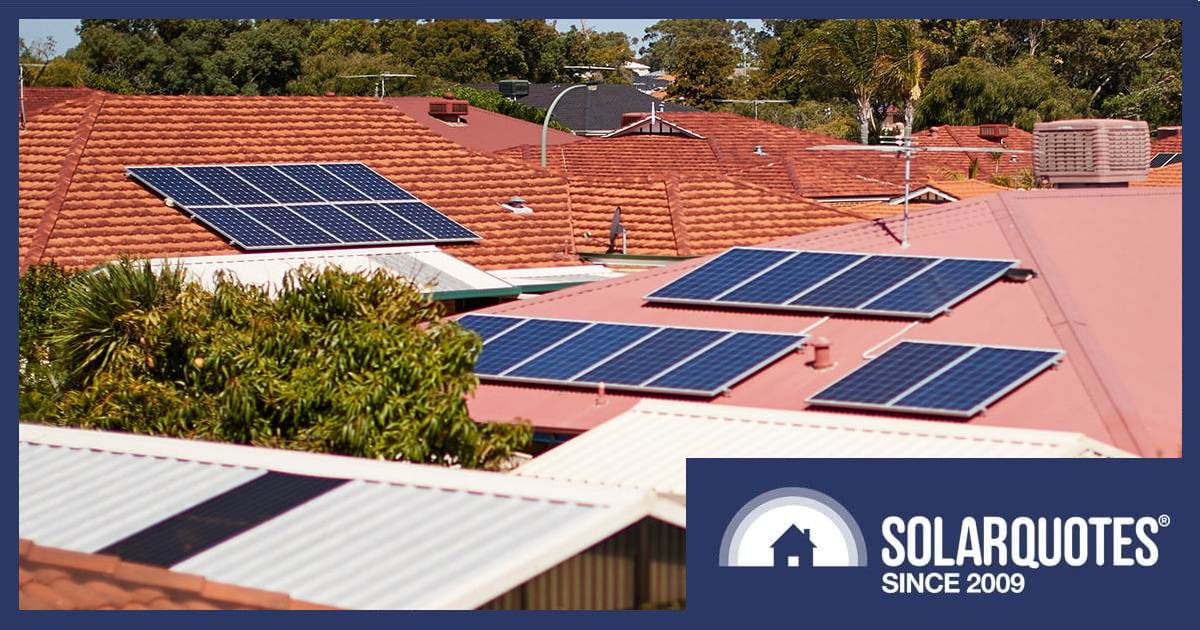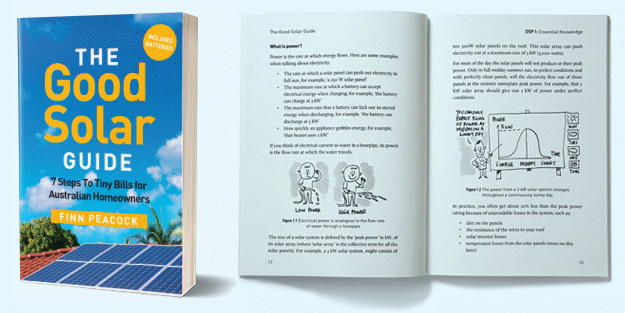
Energy Policy WA is consulting on proposed rule changes to kick in early next year that aim to support larger and more small-scale rooftop solar and battery installations in Western Power’s service area through the implementation of flexible solar exports.
What Are The Proposed Smarter Solar Changes For WA?
At this stage, from 1 February 20261, Common Smart Inverter Profile – Australia (CSIP-AUS) support will need to be present and enabled when installing new or upgrading existing rooftop solar and battery systems in Western Australia’s southwest grid (SWIS). The SWIS extends from Kalbarri in the north, east to Kalgoorlie, and south to Albany. Western Power operates the SWIS and Synergy is the government-owned electricity retailer.
CSIP-AUS enables smart inverters and energy management systems to work with dynamic/flexible connection options, which allows the remote throttling of exports to the mains grid based on network conditions. Most newer inverters support CSIP-AUS.
While inverters installed since February 2022 are already required to be able to communicate with the electricity network, arrangements for emergency solar management functionality have been limited to remote disconnect/reconnect. Flexible exports provides a more elegant solution.
Those with existing solar panels or batteries will not need make changes to their systems. Inverters replaced with a similar or exact replacement under warranty would also not be affected by the changes.
Internet connection is required for flexible exports, but for new/upgrading solar customers without a connection or with an unstable one, their systems will be subject to a fixed 1.5 kW export limit. The same will apply to new/upgrading customers preferring not to use the CSIP-AUS functionality for flexible exports. Customers with existing systems — including those already with a fixed 1.5 kW export limit — will be able to opt in to flexible exports when it’s available, assuming system compatibility.
The proposed approach is similar to the one used in South Australia says Energy Policy WA. SA Power Networks (SAPN) pioneered flexible exports and its implementation allows a 10 kW export limit, dynamically reducing that limit when required.
I didn’t see a mention of the upper limit for WA flexible exports. Western Power currently has a 10 kW solar inverter limit on single phase, with a 5 kW export limit. On three-phase, there’s a 15 kW inverter limit and 5 kW export limit. Battery inverters do not count towards phase inverter limit, but limited to 10 kW on single-phase (15 kW total site generation limit) and 15 kW on three phase (8 kW per phase site generation)2.
Why Are The Smarter Solar Changes Needed?
Western Australia’s southwest grid is the world’s biggest isolated power system. Rooftop solar already contributes around half of the renewables-based electricity flowing into it. More than 548,000 small-scale solar systems (<100 kW capacity) have been installed across the state to date.
The level of surplus solar energy flowing into the grid is creating challenges in terms of balancing electricity supply and demand, and in some areas local networks are becoming congested. While home battery uptake will help alleviate this, flexible exports will be an important tool.
“We want to support as many people in Western Australia as possible to benefit from rooftop solar, and for those people to get the maximum benefit from each system,” says Energy Policy WA. “These changes make it possible for installers to continue connecting more and bigger systems to the distribution network without waiting for network capacity upgrades, and for electricity retailers to begin rolling out flexible solar exports.”
Energy Policy WA says the change will also “make it easy” for customers to opt in and out of virtual power plants (VPPs). There’s little VPP choice in Western Australia at the moment, but VPP participation is compulsory under the WA residential battery rebate. But giving a third-party control over their battery has proved to be a deal-breaker for some WA solar owners, who have foregone the state incentive and opted for the national battery rebate scheme only.
For further information on Smarter Solar, Energy Policy WA have published infosheets for solar customers here and solar installers/retailers here.
Other Bits
The proposed rules would also designate Western Power as the distribution system operator (DSO) for networks it operates, and set up a framework for third-party VPP operators to compete for non-contestable electricity customers through Synergy as the parent aggregator.
Energy Policy WA’s exposure draft of the Electricity System and Market Rules can be accessed here, along with instructions for providing feedback. Feedback needs to be submitted before 5:00pm (AWST) Thursday, 20 November 2025.
Footnotes
- Previously, flexible exports were expected to be rolled out by Western Power in mid-2025. ↩
- 29/10/2025: Corrections have been made to inverter limits in this article. New limits came into effect on July 1, 2025. We will also update our WA grid connection guidelines page to reflect the new limits. ↩

 RSS - Posts
RSS - Posts



Does that last bit mean you could get to use a vpp not run by your electricity supplier?
If so that is a big step forward!
Seems like a good idea to me. My new battery is often full by lunchtime on a sunny day so I get throttled down to 1.5 kW for most of the afternoon, it would be great if more of that could make it onto the grid.
I’m not fussed by the ~2c/kWh buyback, part of my motivation for buying a biggish system was for the greater good – but right now I’m limited to export enough to power two-thirds of a kettle…?
If that 10KW export limit is introduced with a 10c/kWh feed in tarriff after 3pm with throttlling around midday when my battery is still charging then I am in. The current 5kW export limit is useless with 8 to 10kW of PV generation and a full battery.
Currently, the economics does not work, payback >10yrs, for 8 to 10kW of solar and 15kWh of batteries to supply my needs 99% of the year with blackout backup even with the Synergy VPP and Fed govt rebate!
“Western Power currently has a 5 kW solar inverter limit on single phase, with a 5 kW export limit. ”
I believe that this has previously been shown, in this blog, to be wrong, being superseded.
”
Table 4.1:
Maximum System Capacities for Large network category
Connection Basic
service
EG
(Large
system
Networks) phase
Maximum Inverter Capacity (2)
Single energy source
(i.e. no Battery System)
Battery System
AC Coupled or DC coupled
(1)
SiteExport limit(3)(4)(5)
Generation
Limit (6)Static Maximum
Limit
limit
Single-
phaseSingle-
phase10 kVA10 kVA15 kVA1.5 kW5 kW
”
Maximum capacity – single phase inverter – 10kW
See Table 4.1, page 16 (the page numbered “Page 7” of the document
“Basic Embedded Generator
(EG) Connection Technical
Requirements
Public
12 June 2025”
Effective 1 July 2025.
See
https://www.westernpower.com.au/resources-education/technical-documentation/distribution-network-documentation/basic-embedded-generator-connection-technical-requirements/
It took 90 days for me fighting WP the entire way but yes 5kw solar plus 10kW BESS single phase inverters is possible.
Or combination similar.
They are still referring back to a Technical Rules 2016 which is in conflict to the updated embedded generation document 2025.
Hi Darren,
I’d love to hear the details. We wrote up a few points about Fronius managing to bludgeon them into using a 10kW Gen24 Primo here…
https://www.solarquotes.com.au/blog/fronius-winter-solar-wa/
From the document linked to above.
Table 4.1: Maximum System Capacities for Large network category
Site Generation Limit (6) 15kVa single phase and 3phase 8kVa/phase.
Its not a 10kVa limit if you read the document correctly for majority of Western Power customers.
Under clause 4.3.2 you could in theory go higher as long as the total system output can dynamically ramp to the generation value. Not to be confused with an export limit.
However there is as I mentioned a 2016 Technical Rules in play that is in conflict, but hopefully I have paved the way past that.
https://www.westernpower.com.au/siteassets/documents/documents-and-policies/technical-rules/residential-bess-technical-rules-exemption-request.pdf
For myself I had an existing Fronius Primo 5kW on a shed and today the power button was pressed for a Sigenergy 10kW BESS at the house.
1.5kW export limited but no export FIT as over 5kW installation.
It was a long fight, and what combinations they will approve remains to be seen.
Brilliant Darren,
Thanks for the pointers ad thanks for persevering with the DNSP, they deserve every bit.
Without FIT above 5 kW my home can’t justify a solar system & battery setup for near self sufficiency with blackout backup of at least a day. That includes using state & federal rebate and $10k interest free loan benefit.
I need a near 15kW 3 phase inverter system to run my central a/c ! My battery calculated size is to charge to after lunch so I can then export to capture the 10c/kWh feed in tarriff after 3pm.
This just shows the stupidity of the state govt/Synergy regulations which disincentivise my situation.
The web page at
https://www.solarquotes.com.au/grid-connection/wa/
needs updating – it is months out of date.
See my previous post in the Comments section of this article – it includes source citations.
Thanks for flagging Bret, we’ll look into it.
Hi Bret,
We did do some fact finding for this WA article you might like.
https://www.solarquotes.com.au/blog/fronius-winter-solar-wa/
This is great to see, it’s so sad to see many systems export limited under the current rules.
We decided not to rake the state rebate, any time the state government says mandatory its a big turn off, we have a 32kW battery and 15.2kW of solar on a 3ph system, at the moment we get no FIT so Western Power/synergy can get stuffed.
We would be happy to sell power when needed but on our terms not theirs as per VPP providers over East, we need to get third party VPP’s going who can be transparent and sensible and not greedy.